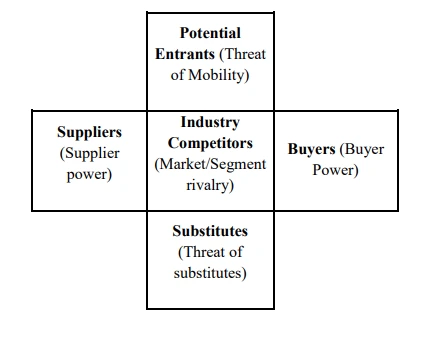
Competition Analysis in Marketing
In today’s increasingly competitive market, it is no longer enough to understand customers for a firm to succeed. Firms must pay close attention to their competition. They need to constantly compare their products, prices, channels and also promotional efforts with their close competitors, to identify areas of competitive advantage and disadvantage. Lets See in detail about the Competition Analysis in Marketing
What is Competition Analysis in Marketing?
- Competitor Analysis Defined Competitor analysis provides both an offensive and a defensive strategic context for identifying opportunities and threats. The offensive strategy context allows firms to more quickly exploit opportunities and capitalize on strengths. Conversely, the defensive strategy context allows them to more effectively counter the threat posed by rival firms seeking to exploit the firm’s own weaknesses.
- Through competitor analysis, firms identify who their key competitors are, develop a profile for each of them, identify their objectives and strategies, assess their strengths and weaknesses, gauge the threat they pose, and anticipate their reaction to competitive moves. Firms that develop systematic and advanced competitor profiling have a significant competitive advantage.
6 Steps of Competition Analysis in Marketing

1) Identifying Current and Potential Competitors
- To identify their current and potential competitors, firms have to use both an industry approach as well as a market approach. The industry approach will yield insights on the structure of the industry and the products offered by all market participants.
- The market approach on the other hand, focuses on the customer need and the firms attempting to satisfy those needs, which will provide the firm with a wider view of current and potential competitors.
Sources of potential competitors
- It include (but are not limited to) firms which compete in a related product, use related technologies, already target the same market even if with unrelated products, operate in other geographical areas with similar products and, last but not least, new start-ups organized by former company employees and/or managers of existing firms.
- Firms focusing on the same target market with the same strategy constitute a strategic group and also are the closest competitors to firms intending to enter such a group.
2) Industry-Based Analysis
An “industry” is defined as a group of firms whose products and services are close substitutes of each other. Industries are primarily classified according to the number of sellers involved and also the degree of product differentiation.
- Monopoly exists when only one firm supplies a given product/service in a certain country or area
- Oligopoly consists of a few firms producing basically the same commodity, such as Mobil, Shell and Sunoco, in the fuel industry
- Differentiated oligopoly refers to an industry in which a few firms produce partially differentiated products, such as Sony, Canon and Nikon in the digital camera industry.
- Monopolistic competition refers to a situation where several competing firms in an industry are able to differentiate their offer in whole or in part
3) Market-based Analysis
From a market perspective, rather than looking at companies making the same product as its only competitors, a firm looks for its competitors among those companies that satisfy the same customer need.
On the basis of the degree of product substitution, for example, companies can face brand competition, industry competition, form competition and generic competition.
- Brand Competition
- Industry Competition
- Product Competition
- Generic Competition
4) Competitor Profiling

- Once a firm has identified its primary competitors, it needs to assess and analyze their objectives, strategies, strengths and weaknesses as well as their competitive reactions.
- Whether or not a competitor can carry out its objectives and strategies depends on its resources and also capabilities. For this reason, the analysis of the corresponding strengths and also weaknesses constitutes key information for a firm analyzing its competitors. The technique typically used to conduct this analysis is called “SWOT (Strengths, Weaknesses, Opportunities and Threats) Analysis”.
- The results of a SWOT Analysis are presented in the form of a matrix, as shown in the case of the Ben & Jerry’s Ice Cream Example (Figure). Additional examples of SWOT Analyses are included in Supplement 1 at the end of this module.
5)Assessing Market Attractiveness

- Before entering a particular market (or market segment), a firm needs to assess its attractiveness.
- According to Michael Porter, the attractiveness of a market or market segment, is determined by the opportunities and threats posed by five key elements: industry competitors, potential market entrants, availability of product substitutes, buyers’ power and also suppliers’ power.
6) Designing Competitive Strategies
- The roles played by firms in an industry can be usefully classified into: market leader, market challenger, market follower or market nicher.
- A firm can gain further insights about its competitors and design more effective competitive strategies by identifying its role and that of its competitors
LIKE WHAT YOU’RE READING?
CHECK OUT SOME OF OUR OTHER GREAT CONTENT HERE:
- MARKETING MANAGER ROLES AND RESPONSIBILITIES
- CONTENT MARKETING STRATEGIES FOR SMALL BUSINESSES
- DEFINITION OF MARKETING MANAGEMENT
- ROLE OF BLOGS IN MARKETING
- UNDERSTANDING DIGITAL MARKETING
- WHAT IS AFFILIATE MARKETING? (HOW TO GET STARTED)
- PERFORMANCE MARKETING – A BEGINNER’S GUIDE
- EFFECTIVE BRANDING METHODS
- UNDERSTANDING CONSUMER BEHAVIOR
- HOW TO INCREASE SALES?
- HOW AI IS USED IN DIGITAL MARKETING?
- 5 BEST SOCIAL MEDIA PLATFORMS FOR BUSINESS IN 2022
- WHAT IS THE DEFINITION OF ECOMMERCE
- ROLE OF SOCIAL MEDIA IN MARKETING
- WHAT IS ZERO-BASED BUDGETING
- DECODING DIRECT MARKETING WITH EXAMPLES
- CONCEPT OF HOLISTIC MARKETING – EXPLAINED




7 Comments